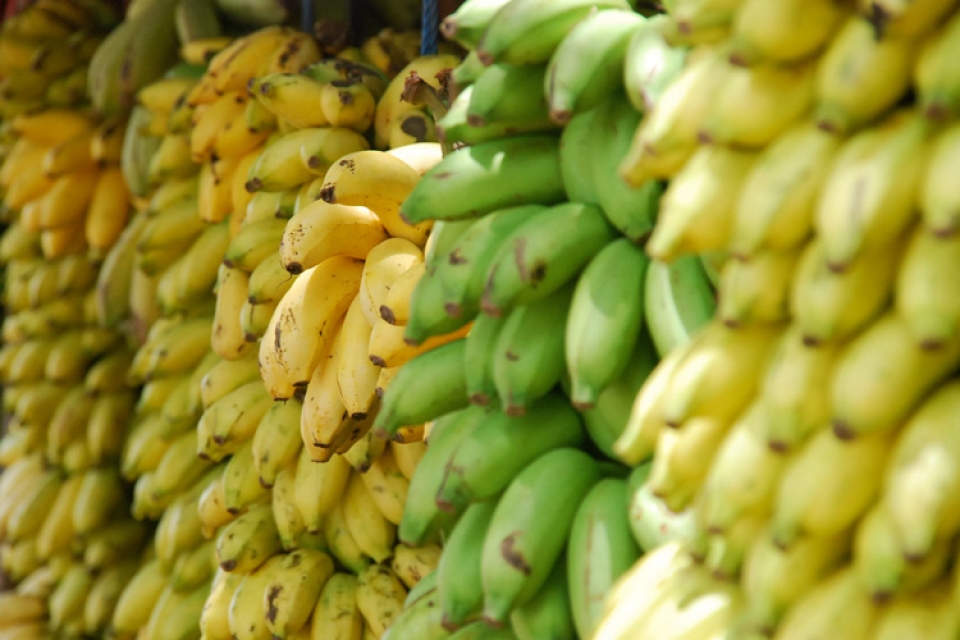A Banana of a Different Color
Did you know that the bananas you typically see at any grocery store in the US are all genetically the same? The variety of banana that has become what we now think of as “the banana” is the Cavendish banana. But the Cavendish hasn’t always been the most popular banana around, and due to a fungal disease, the Cavendish may cease to be our go-to banana in the future.
Let’s start with a primer on banana propagation: because most cultivated banana varieties are seedless, bananas must be propagated vegetatively. What this means is that farmers remove suckers from the base of existing banana trees when the suckers get to be about 3 feet tall, making sure to take some of the original root stock with it. The suckers grow from the main stem, and thus are genetically the same as the original plant. The sucker is then planted and allowed to grow into a new tree.
Now for some history: up until about the 1950s a different variety of banana was the most globally exported. It was known as the Gros Michel. It was just about wiped out by a fungal disease known as Panama disease, or banana wilt, in the 1950s, which is when growers turned to growing Cavendish bananas. While the Cavendish was smaller and less flavorful than the Gros Michel, at the time, Cavendish bananas were able to grow in soils that were infected with Panama disease, and they were hardy enough to endure global transport.
While the Cavendish is now the most widely exported banana, it certainly isn’t the only variety of banana grown. In countries where it is easier to grow bananas, it’s possible find a diversity of banana varieties at the market. From time to time, even City Market will carry varieties other than Cavendish. For example, this summer we received shipments of Apple Bananas and Thai (Lemon) Bananas.
Apple bananas, which are the most preferred banana in Mexico, are snack-sized and when mature are tangy with a sweet apple flavor with hints of pineapple and strawberry. When they are ready to eat, the color of the peel is dark yellow with dark black streaks.
Apple bananas - need to ripen to dark yellow before eating
Thai (Lemon) bananas are the most preferred banana in Asia. They are small fingered, plump, tangy, and full-bodied. These bananas are great for cooking when green (you can substitute them for plantains) and are also a great variety for dehydrating. They are also delicious when allowed to fully ripen to a darkened yellow black.
Thai (Lemon) Bananas - close to being fully ripe!
But back to the Cavendish. There is now a new strain of Panama disease (known as Tropical Race 4), and unfortunately, the Cavendish is no longer immune. Tropical Race 4 has affected banana plantations in China, Southeast Asia, Australia, and Africa, but has not yet hit Latin America. While this doesn’t mean the Cavendish is going to disappear from shelves in the near future, it does mean that the Cavendish will be harder and harder to grow, and right now, there isn’t another banana variety that can replace the Cavendish to the extent to which it is exported.
Researchers are trying to find varieties of bananas that are immune to Tropical Race 4. So far what they’ve discovered is that the varieties that are immune are typically wild varieties that have a lot of seeds that make the fruit unpalatable, or have a lot of starch, like plantains. Plant breeders will need to take these few immune varieties and cross breed them with tastier varieties to hopefully develop several new varieties that are resistant to Tropical Race 4. The catch here goes back to banana propagation. In order for plant breeders to create new varieties, they need to start with a banana that has seeds (so there will be genetically different offspring) and then eventually develop a banana that has no seeds in order to be palatable.
So, there’s still some work to do on the banana breeding front. For now, researchers are trying to contain the spread of Tropical Race 4 to prolong the Cavendish as long as possible. In the meantime, when we have them, give some other banana varieties a try – you might just find a new favorite!
